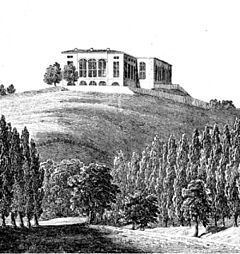Closed 1934 | Established After 1787 | |
 | ||
Gotha Observatory (Seeberg Observatory, Sternwarte Gotha or Seeberg-Sternwarte) was a German astronomical observatory located on Seeberg hill near Gotha, Thuringia, Germany. Initially the observatory was dedicated to astrometry, geodetic and meteorological observation and tracking the time.
Contents
The minor planet 1346 Gotha was named after the city of Gotha in recognition of the observatory.
History
Planning for the observatory began in 1787 by the court astronomer Baron Franz Xaver von Zach, with the financing of Ernest II, Duke of Saxe-Gotha-Altenburg. It was based upon the Radcliffe Observatory in Oxford, England. The building was divided into five parts, with the central section holding a revolving dome. There were two wings to provide quarters for the staff.
During Hansen's term, the observatory was dismantled and moved to a less exposed location in Gotha. The observatory was closed in 1934.
Instruments
Around 1800, the observatory became an international center for astronomy, being the most modern astronomical institute primarily for its instruments. The instruments came from London, England, the standard place to acquire them in the 18th century. These included an eighteen inch quadrant, a two foot transit instrument, three Hadley sextants, an achromatic heliometer, a two foot achromatic refractor, a Gregorian reflector and many clocks.
By the start of the nineteenth century improved instrumentation was acquired: consisting of a theodolite, a different heliometer, new mounting, and three foot meridian circle. No spectroscopy or photography was performed at the observatory and the only astrophysical equipment of the observatory was a Zöllner photometer.
Directors
The observatory directors were as follows:
